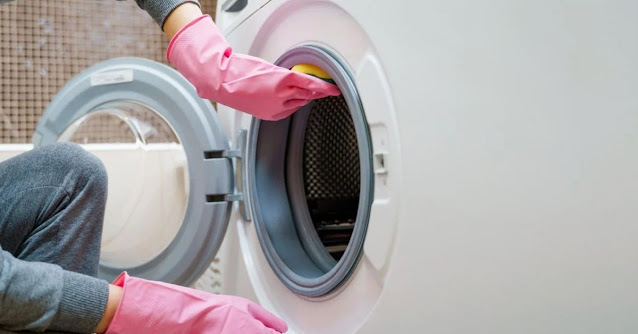How to Clean a Washing Machine?
The convenience and ease of washing clothes has increased thanks to technological advancement. Hand washing clothes requires scrubbing and washing dry, dirty clothes. The whole process can be long and tiring.
Although the washing machine is able to clean towels, clothes, and other household items, it will need to be cleaned periodically. It will be apparent that your washing machine isn't working properly. Lint appears The clean-o-meter's reading is very low and it's likely that the stains will never disappear. When these symptoms are present, your washing machine needs a thorough clean. This article will show you what you can do to completely clean your washer to benefit from the most efficient and efficient washing machine.
Which is the most effective method to clean the inside of a Washing Machine, Vinegar, or Bleach?
Although both bleach and vinegar can clean the washing machine, it's important to avoid using both simultaneously! When bleach and vinegar are mixed there is a chemical reaction which results in the creation of toxic gasses. In the case of cleaning machines, going to bleach is the most effective choice if you want quick, thorough cleaning. However vinegar is more sustainable.
A small amount of bleach and water can be a miracle! The only drawback is the possibility of the possibility of discoloration when used excessively, however bleach is great to clean surfaces. You can run the cycle for 5 minutes with only 1/4 cup of bleach per each one cup of water. Vinegar is the easiest alternative that people have in their home for those who aren't keen on using bleaching products and fear that it could affect clothing colors. Because vinegar is a standard household item that is affordable to buy in most supermarkets as well, it's also the most affordable alternative. Add the vinegar in two cup portions to the soap drawer in your washing machine to be used to clean the machine. When the drum is empty, run the most hot cycle you can.
Clean Your Front-Loading Washer Effectively
The growth of mildew and mold can happen quickly in the front load washers particularly in seals made of rubber. Cleansing a front load washer does not require a lot of effort or lengthy. The simple steps below can help you complete the job quickly and efficiently. Before you begin, be sure that there's no clothing within.
- Take off the gasket for your washer's door to let you see the inside. "The gasket is the rubber ring that runs along the opening of your washer's drum". Odors and mold can develop quickly in the machine due to water and soap residue in the gasket's rubber, and the warm climate that is there. Each month, you should completely clean your gasket. Mix 1 cup bleach into the tub that is empty of water in your machine before running an intense cycle to get rid of the mildew. You can run one or two rinse-only hot cycles when the cycle is complete to clean the machine and rid it of the bleach smell. Examine for items (like coins, pins and hair) in between the rubbers upon taking off the gasket. If you use your washing machine with sharp items, those that are stuck within the gasket may cause harm to it as well as the machine itself.
- The drum must be cleaned after that. Just pour 2 cup of vinegar white into the dispenser for detergent and follow it with one-third cup baking soda into the drum that is washing. That is all that is needed. Completely clean the cycle using hot water. This will rid yourself of mildew and mold.
- Clean the panel of the detergent dispenser by getting rid of it. Take the panel out of the dispenser and then soak the panel in hot water. The panel needs to be removed off and scrubbed with an all-purpose cleaner. Then, put it back following a thorough clean.
- Make sure to finish with a damp cloth to wash the exterior and the controls. The appliance is now clean inside and outside. It is crucial to make sure you apply the right detergent while washing the inside of your Front-loading washing machine in addition take your laundry out as soon when you are completed.
The Best Way to Clean Your Top-Loading Washer
A washing machine that has top-loading drums is called an top loader machine. While this kind of washer is generally cheaper than other models but it comes with its own disadvantages. The fact that top-loader washing machines take extra effort for cleaning than front loading machines is just one of the major disadvantages. While top loaders tend to be less likely have mildew on the gasket of the door than front loaders do but they do require regular maintenance and cleaning to ensure they are operating properly.
- As mentioned previously Make sure there's no clothing inside prior to beginning. Select the self-cleaning cycle in the event that your top-loading washer comes with one. If not make sure that you set your washing machine to run the longest cycle and the largest load and the hottest water that you can. The machine should be filled before you begin the process. Pour 2 cups white vinegar into the water after the machine is filled, but before it starts to stir. The machine should be empty when you run it through hot water and about 2 cups of vinegar white to rid the machine of mildew and mold smells and an accumulation of fabric and soap remnants. In lieu of vinegar you could employ 1-cup bleach however, bleach can cause damage to gaskets made of rubber.
- Remove the detergent dispenser slowly, then put it into warm soapy water. Rub it vigorously to eliminate any residue that remains.
- Also, wash the inside and the inside of your drawer. Scrub the edges and inside of the door using warm soapy water. Clean the top of your wash machine's agitator , if it is equipped with one. Since water tends to drip down this area, it will be cleaner. After that, wash them with water.
- Be sure to clean your equipment outdoors. Make use of a moist microfiber cloth to clean its controls as well as the rest of its body to rid it of grime, dirt and spills from laundry products.
- Making use of a liquid detergent with bleach is a good way to keep your top loading washer clean and free from mildew and mold. This means less frequent washing is required as your clothes will be clean for longer time.




Comments
Post a Comment